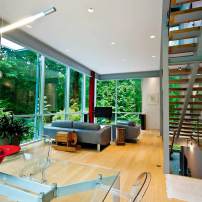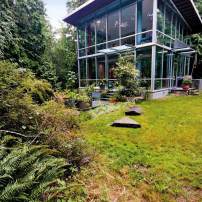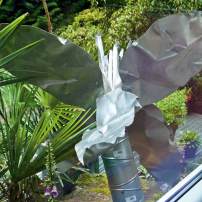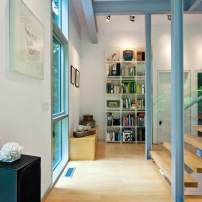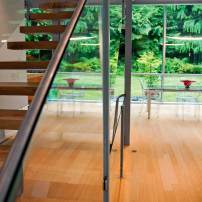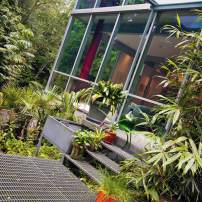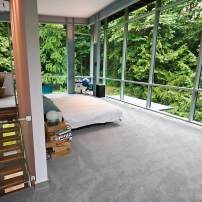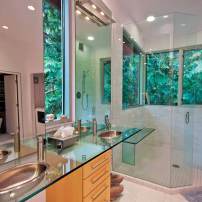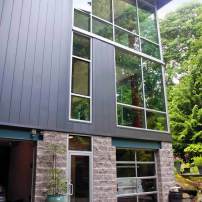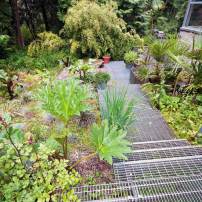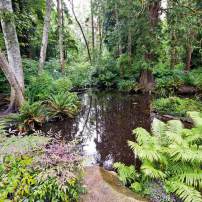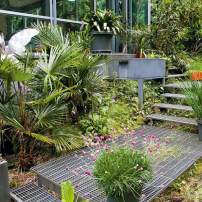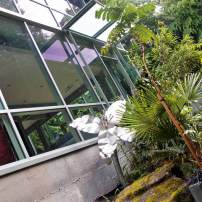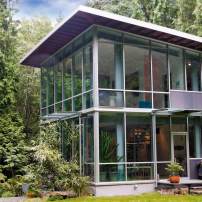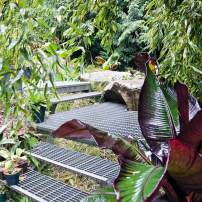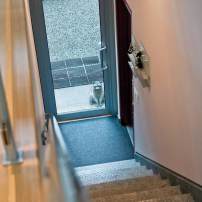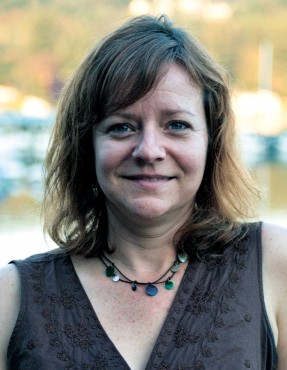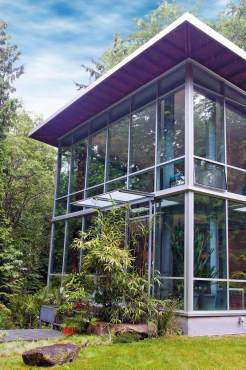 Off a narrow, wooded road on Bainbridge Island, a long, tidy gravel driveway leads through the trees. Past the unremarkable gate at the top of the drive, visitors enter the hushed tranquility of the forest. Large trees rise up on both sides and, as the property slopes up toward the house, a natural creek passes first through the wide roots of an ancient tree, then under the driveway itself, before collecting into a small, still pond.
Off a narrow, wooded road on Bainbridge Island, a long, tidy gravel driveway leads through the trees. Past the unremarkable gate at the top of the drive, visitors enter the hushed tranquility of the forest. Large trees rise up on both sides and, as the property slopes up toward the house, a natural creek passes first through the wide roots of an ancient tree, then under the driveway itself, before collecting into a small, still pond.
It’s a scene that leads you to the image of a cozy log cabin at the end of your path, with smoke curling from the chimney and perhaps a rocking chair or two on the wide front porch.
But what you find instead is something entirely different: a thoroughly modern structure of metal and glass that rises up three stories into the surrounding trees.
Though this close juxtaposition of the pastoral setting and this modern home may be surprising initially, for one of the homeowners*, it’s exactly what he was looking for.
“It makes perfect sense to have a house that was all glass,” he says, “in order to be able to immerse yourself in the land.”
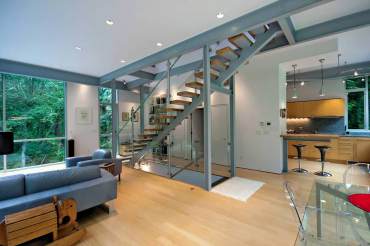 The story of this house began a few years ago, when the couple were looking for a new home. The 1,200-square-foot house they lived in on the property no longer suited their needs and they thought that a house along the water would be a good fit. But they kept coming back to how much they loved their piece of land.
The story of this house began a few years ago, when the couple were looking for a new home. The 1,200-square-foot house they lived in on the property no longer suited their needs and they thought that a house along the water would be a good fit. But they kept coming back to how much they loved their piece of land.
So instead of moving, the pair decided to build a new house on the property, then have the old house removed and donated to the nearby wildlife center.
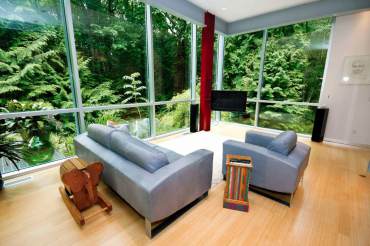 With the location selected, the homeowners set to work to create the house of their dreams. From the beginning, they envisioned a modern home that was open, airy, and took full advantage of the secluded forested property.
With the location selected, the homeowners set to work to create the house of their dreams. From the beginning, they envisioned a modern home that was open, airy, and took full advantage of the secluded forested property.
“We didn’t really want walls,” the owner says. “We wanted a minimalist feel.”
To help bring this vision to life, the couple enlisted the help of architect Devin Johnson of the Bainbridge Island architectural and planning firm Johnson Squared.
“We had a great time,” the homeowner says of the design process. “They clearly had the vision we had.”
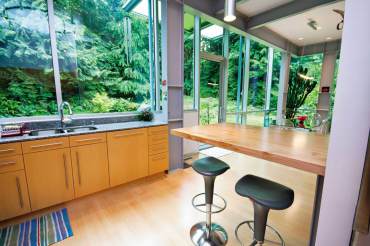 The home itself is designed in a simple box shape built of exposed steel beams, columns and glass walls, and capped with a steel roof. Deep roof overhangs help control light and shade inside the home, and the house was built so as to make maximum use of the natural breezes and air currents on the property.
The home itself is designed in a simple box shape built of exposed steel beams, columns and glass walls, and capped with a steel roof. Deep roof overhangs help control light and shade inside the home, and the house was built so as to make maximum use of the natural breezes and air currents on the property.
The long driveway ends around the back of the house at the ground-floor, glass-doored, two-car garage. The garage includes reinforcements for installing a car lift in the future, as well as a spacious workbench that spans the back of one of the car bays.
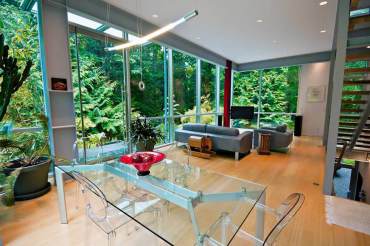 A central staircase with industrial, stamped-metal stairs leads up from the garage to the main floor, where floor-to-ceiling glass walls provide an almost completely unobstructed, 180-degree view of the surrounding property.
A central staircase with industrial, stamped-metal stairs leads up from the garage to the main floor, where floor-to-ceiling glass walls provide an almost completely unobstructed, 180-degree view of the surrounding property.
The minimalist, modern furnishings in the combined living and dining areas have little impact on the wide, open room that dominates the first floor, anchored by steel beams and surrounded by glass. The glass dining table and clear chairs — “ghost chairs” by designer Philippe Starck — nearly recede from view and the clean, low lines of the living room seating, arranged around a simple white rug, allow the glass walls to remain the focal point of the space. A single steel column is painted Chilean red, in a striking contrast to the industrial steel-gray of the rest of the columns.
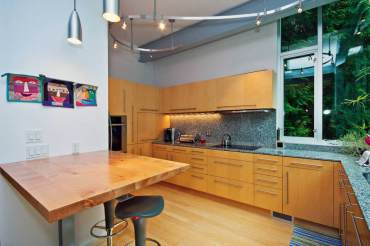 The kitchen is small but highly functional, with an enviable number of maple cabinets and dark granite countertops that offer plenty of workspace. The cabinets vary in both size and function — some slide out, some open horizontally — which is both an attractive design touch and an effective way to maximize the available space.
The kitchen is small but highly functional, with an enviable number of maple cabinets and dark granite countertops that offer plenty of workspace. The cabinets vary in both size and function — some slide out, some open horizontally — which is both an attractive design touch and an effective way to maximize the available space.
Three doors along the first floor’s one “conventional” wall hide a spacious guest bath, guest room and storage, helping to maintain the house’s clean, uncluttered lines. Light bamboo flooring and soaring 12-foot ceilings throughout the first floor add to the light and airy feel.
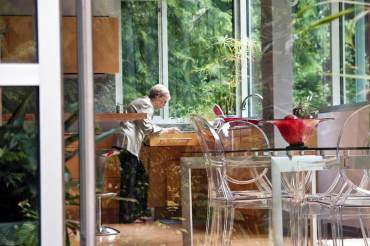 A second central staircase, with glass side panels and heavy-hewn maple treads that seem to float along a central support, leads to the second floor of the home. The treads are from the one tree that had to be removed from the property when the house was built, and the light finish nicely accentuates the wood’s natural texture.
A second central staircase, with glass side panels and heavy-hewn maple treads that seem to float along a central support, leads to the second floor of the home. The treads are from the one tree that had to be removed from the property when the house was built, and the light finish nicely accentuates the wood’s natural texture.
The second floor is dominated by the master bedroom, which is furnished with just a low, futon-style bed and two small side tables that the homeowners created using unfinished pieces from that same maple tree, stacked together at various angles. A large piece of custom artwork fits perfectly on the wall over the bed but, as on the first floor, the focal point of this room is the view. Here, the glass walls stretch up on three sides to the 14-foot ceiling. The single red column carries up into this room from below, adding a touch of warmth to the otherwise spartan space.
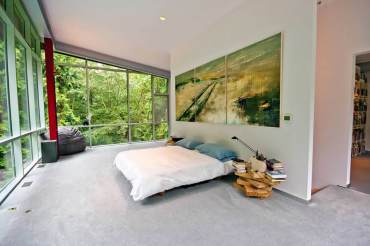 The master bathroom is a study in white and glass, with a generous corner shower surrounded by glass, a glass countertop fitted with two stainless-steel sinks and gleaming white tiles on the floor and walls. The door to the master bedroom’s large walk-in closet is tucked around the corner in the bathroom, providing plenty of storage space.
The master bathroom is a study in white and glass, with a generous corner shower surrounded by glass, a glass countertop fitted with two stainless-steel sinks and gleaming white tiles on the floor and walls. The door to the master bedroom’s large walk-in closet is tucked around the corner in the bathroom, providing plenty of storage space.
A home office rounds out the second floor, on the opposite side of the stairway from the master bedroom. The desktop is a custom piece designed to fit around the steel beams; it provides enough space for two computer workstations.
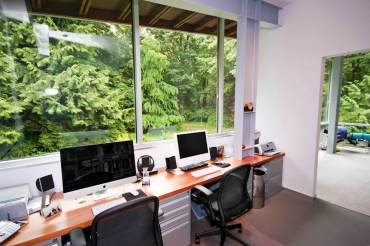 Overall the house has about 2,000 square feet of livable space — and around 2,600 square feet of glass.
Overall the house has about 2,000 square feet of livable space — and around 2,600 square feet of glass.
With all that glass and not a single curtain or shade in sight, it seems like the feeling of exposure would be inevitable. But, according to the homeowners, that’s not the case. Their 2.5-acre lot butts up to several other heavily wooded lots and is close to wetlands that can’t be developed, making the property the perfect location to build a house made of glass, a tranquil, secluded retreat that allows the couple to fully enjoy the natural world, inside the comfort of their own home.
“The whole house was perfect in terms of what we wanted,” one of the homeowners says. “There’s no other place where we’d want to be.”




